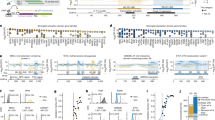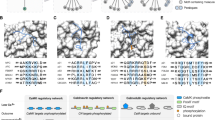Abstract
The LIM domain is a cysteine-rich zinc-finger motif found in a large family of proteins. In LIM-homeodomain (LIM-hd) transcription factors and LIM-only (LMO) factors, the LIM domains are responsible for key interactions with co-activators, co-repressors, competitors, and other transcription factors, and are therefore of considerable importance for the regulation of associated transcriptional activity. In this review, the authors describe the progressive discoveries of NLI/Ldb/CLIM, LMO and RLIM, and discuss how the field was very recently updated by the finding that LIM-hd transcriptional activity is controlled by regulated degradation of cofactors and LIM-hd themselves.
Similar content being viewed by others
References
Sanchez-Garcia, I. and Rabbitts, T. H. (1994). The LIM domain: a new structural motif found in zinc-finger-like proteins. Trends Genet. 10, 315–320.
Dawid, I. B., Breen, J. J., and Toyama, R. (1998). LIM domains: multiple roles as adapters and functional modifiers in protein interactions. Trends Genet. 14, 156–162.
Freyd, G., Kim, S. K., and Horvitz, H. R. (1990). Novel cysteine-rich motif and homeodomain in the product of the Caenorhabditis elegans cell lineage gene lin-11. Nature 344, 876–879.
Karlsson, O., Thor, S., Norberg, T., Ohlsson, H., and Edlund, T. (1990). Insulin gene enhancer binding protein IsI-1 is a member of a novel class of proteins containing both a homeo- and a Cys-His domain. Nature 344, 879–882.
Way, J. C. and Chalfie, M. (1988). mec-3, a homeobox-containing gene that specifies differentiation of the touch receptor neurons in C. elegans. Cell 54, 5–16.
Bachy, I., Failli, V., and Retaux, S. (2002). A LIM-homeodomain code for development and evolution of forebrain connectivity. Neuroreport 13, 23–27.
Bach, I. (2000). The LIM domain: regulation by association. Mech. Dev. 91, 5–17.
Rabbitts, T. H. (1998). LMO T-cell translocation oncogenes typify genes activated by chromosomal translocations that alter transcription and developmental processes. Genes Dev. 12, 2651–2657.
Hobert, O. and Westphal, H. (2000). Functions of LIM-homeobox genes. Trends Genet. 16, 75–83.
Rabbitts, T. H. and Boehm, T. (1990). LIM domains. Nature 346, p. 418.
Dawid, I. B., Toyama, R., and Taira, M. (1995). LIM domain proteins. C. R. Acad. Sci. III 318, 295–306.
Feuerstein, R., Wang, X., Song, D., Cooke, N. E., and Liebhaber, S. A. (1994). The LIM/double zinc-finger motif functions as a protein dimerization domain. Proc. Natl. Acad. Sci. USA 91, 10,655–10,659.
Schmeichel, K. L. and Beckerle, M. C. (1994). The LIM domain is a modular protein-binding interface. Cell 79, 211–219.
Valge-Archer, V. E., Osada, H., Warren, A. J., Forster, A., Li, J., Baer, R., and Rabbitts, T. H. (1994). The LIM protein RBTN2 and the basic helix-loop-helix protein TAL1 are present in a complex in erythroid cells. Proc. Natl. Acad. Sci. USA 91, 8617–8621.
Wadman, I., Li, J., Bash, R. O., Forster, A., Osada, H., Rabbitts, T. H., and Baer, R. (1994). Specific in vivo association between the bHLH and LIM proteins implicated in human T cell leukemia. Embo. J. 13, 4831–4839.
Wu, R., Durick, K., Songyang, Z., Cantley, L. C., Taylor, S. S., and Gill, G. N. (1996). Specificity of LIM domain interactions with receptor tyrosine kinases. J. Biol. Chem. 271, 15,934–15,941.
Sanchez-Garcia, I., Osada, H., Forster, A., and Rabbitts, T. H. (1993). The cysteine-rich LIM domains inhibit DNA binding by the associated homeodomain in IsI-1. Embo. J. 12, 4243–4250.
Xue, D., Tu, Y., and Chalfie, M. (1993). Cooperative interactions between the Caenorhabditis elegans homeoproteins UNC-86 and MEC-3. Science 261, 1324–1328.
Taira, M., Otani, H., Saint-Jeannet, J. P., and Dawid, I. B. (1994). Role of the LIM class homeodomain protein Xlim-1 in neural and muscle induction by the Spemann organizer in Xenopus. Nature 372, 677–679.
Jurata, L. W., Kenny, D. A., and Gill, G. N. (1996). Nuclear LIM interactor, a rhombotin and LIM homeodomain interacting protein, is expressed early in neuronal development. Proc. Natl. Acad. Sci. USA 93, 11,693–11,698.
Agulnick, A. D., Taira, M., Breen, J. J., Tanaka, T., Dawid, I. B., and Westphal, H. (1996). Interactions of the LIM-domain-binding factor Ldb1 with LIM homeodomain proteins. Nature 384, 270–272.
Bach, I., Carriere, C., Ostendorff, H. P., Andersen, B., and Rosenfeld, M. G. (1997). A family of LIM domain-associated cofactors confer transcriptional synergism between LIM and Otx homeodomain proteins. Genes Dev. 11, 1370–1380.
Mochizuki, T., Karavanov, A. A., Curtiss, P. E., et al. (2000). Xlim-1 and LIM domain binding protein 1 cooperate with various transcription factors in the regulation of the goosecoid promoter. Dev. Biol. 224, 470–485.
Arber, S. and Caroni, P. (1996). Specificity of single LIM motifs in targeting and LIM/LIM interactions in situ. Genes Dev. 10, 289–300.
Bach, I. (2000). The LIM domain: regulation by association. Mech. Dev. 91, 5–17.
Jurata, L. W. and Gill, G. N. (1997). Functional analysis of the nuclear LIM domain interactor NLI. Mol. Cell. Biol. 17, 5688–5698.
Jurata, L. W., Pfaff, S. L., and Gill, G. N. (1998). The nuclear LIM domain interactor NLI mediates homo- and heterodimerization of LIM domain transcription factors. J. Biol. Chem. 273, 3152–3157.
Breen, J. J., Agulnick, A. D., Westphal, H., and Dawid, I. B. (1998). Interactions between LIM domains and the LIM domain-binding protein Ldb1. J. Biol. Chem. 273, 4712–4717.
Tsuchida, T., Ensini, M., Morton, S. B., et al. (1994). Topographic organization of embryonic motor neurons defined by expression of LIM homeobox genes. Cell 79, 957–970.
Sharma, K., Sheng, H. Z., Lettieri, K., et al. (1998). LIM homeodomain factors Lhx3 and Lhx4 assign subtype identities for motor neurons. Cell 95, 817–828.
Thor, S., Andersson, S. G., Tomlinson, A., and Thomas, J. B. (1999). A LIM-homeodomain combinatorial code for motor-neuron pathway selection. Nature 397, 76–80.
Segawa, H., Miyashita, T., Hirate, Y., Higashijima, S., Chino, N., Uyemura, K., Kikuchi, Y., and Okamoto, H. (2001). Functional repression of Islet-2 by disruption of complex with Ldb impairs peripheral axonal outgrowth in embryonic zebrafish. Neuron 30, 423–436.
Retaux, S., Rogard, M., Bach, I., Failli, V., and Besson, M. J. (1999). Lhx9: a novel LIM-homeodomain gene expressed in the developing forebrain. J. Neurosci. 19, 783–793.
Nakagawa, Y. and O’Leary, D. D. (2001). Combinatorial expression patterns of LIM-homeodomain and other regulatory genes parcellate developing thalamus. J. Neurosci. 21, 2711–2725.
Bachy, I., Vernier, P., and Retaux, S. (2001). The lim-homeodomain gene family in the developing xenopus brain: conservation and divergences with the mouse related to the evolution of the forebrain. J. Neurosci. 21, 7620–7629.
Bach, I., Rhodes, S. J., Pearse, R. V. 2nd, et al. (1995). P-Lim, a LIM homeodomain factor, is expressed during pituitary organ and cell commitment and synergizes with Pit-1. Proc. Natl. Acad. Sci. USA 92, 2720–2724.
Cohen, B., McGuffin, M. E., Pfeifle, C., Segal, D., and Cohen, S. M. (1992). apterous, a gene required for imaginal disc development in Drosophila encodes a member of the LIM family of developmental regulatory proteins. Genes Dev. 6, 715–729.
Bourgouin, C., Lundgren, S. E., and Thomas, J. B. (1992). Apterous is a Drosophila LIM domain gene required for the development of a subset of embryonic muscles. Neuron 9, 549–561.
Lundgren, S. E., Callahan, C. A., Thor, S., and Thomas, J. B. (1995). Control of neuronal pathway selection by the Drosophila LIM homeodomain gene apterous. Development 121, 1769–1773.
Rincon-Limas, D. E., Lu, C. H., Canal, I., et al. (1999). Conservation of the expression and function of apterous orthologs in Drosophila and mammals. Proc. Natl. Acad. Sci. USA 96, 2165–2170.
Lu, C. H., Rincon-Limas, D. E., and Botas, J. (2000). Conserved overlapping and reciprocal expression of msh/Msx1 and apterous/Lhx2 in Drosophila and mice. Mech. Dev. 99, 177–181.
Hobert, O. and Ruvkun, G. (1998). A common theme for LIM homeobox gene function across phylogeny? Biol. Bull 195, 377–380.
Morcillo, P., Rosen, C., Baylies, M. K., and Dorsett, D. (1997). Chip, a widely expressed chromosomal protein required for segmentation and activity of a remote wing margin enhancer in Drosophila. Genes Dev. 11, 2729–2740.
Torigoi, E., Bennani-Baiti, I. M., Rosen, C., et al. (2000). Chip interacts with diverse homeodomain proteins and potentiates bicoid activity in vivo. Proc. Natl. Acad. Sci. USA 97, 2686–2691.
Fernandez-Funez, P., Lu, C. H., Rincon-Limas, D. E., Garcia-Bellido, A., and Botas, J. (1998). The relative expression amounts of apterous and its co-factor dLdb/Chip are critical for dorso-ventral compartmentalization in the Drosophila wing. Embo. J. 17, 6846–6853.
Shoresh, M., Orgad, S., Shmueli, O., Werczberger, R., Gelbaum, D., Abiri, S., and Segal, D. (1998). Overexpression Beadex mutations and loss-of-function heldup-a mutations in Drosophila affect the 3′ regulatory and coding components, respectively, of the Dlmo gene. Genetics 150, 283–299.
Milan, M., Diaz-Benjumea, F. J., and Cohen, S. M. (1998). Beadex encodes an LMO protein that regulates Apterous LIM-homeodomain activity in Drosophila wing development: a model for LMO oncogene function. Genes Dev. 12, 2912–2920.
Zeng, C., Justice, N. J., Abdelilah, S., Chan, Y. M., Jan, L. Y., and Jan, Y. N. (1998). The Drosophila LIM-only gene, dLMO, is mutated in Beadex alleles and might represent an evolutionarily conserved function in appendage development. Proc. Natl. Acad. Sci. USA 95, 10,637–10,642.
Dawid, I. B. (1998). LIM protein interactions: Drosophila enters the stage. Trends Genet. 14, 480–482.
Milan, M. and Cohen, S. M. (2000). Temporal regulation of apterous activity during development of the Drosophila wing. Development 127, 3069–3078.
O’Keefe, D. D., Thor, S., and Thomas, J. B. (1998). Function and specificity of LIM domains in Drosophila nervous system and wing development. Development 125, 3915–3923.
Milan, M. and Cohen, S. M. (1999). Regulation of LIM homeodomain activity in vivo: a tetramer of dLDB and apterous confers activity and capacity for regulation by dLMO. Mol. Cell 4, 267–273.
van Meyel, D. J., O’Keefe, D. D., Jurata, L. W., Thor, S., Gill, G. N., and Thomas, J. B. (1999). Chip and apterous physically interact to form a functional complex during Drosophila development. Mol. Cell 4, 259–265.
Rincon-Limas, D. E., Lu, C. H., Canal, I., and Botas, J. (2000). The level of DLDB/CHIP controls the activity of the LIM homeodomain protein apterous: evidence for a functional tetramer complex in vivo. Embo. J. 19, 2602–2614.
van Meyel, D. J., O’Keefe, D. D., Thor, S., Jurata, L. W., Gill, G. N., and Thomas, J. B. (2000). Chip is an essential cofactor for apterous in the regulation of axon guidance in Drosophila. Development 127, 1823–1831.
Bach, I., Rodriguez-Esteban, C., Carriere, C., et al. (1999). RLIM inhibits functional activity of LIM homeodomain transcription factors via recruitment of the histone deacetylase complex. Nat. Genet. 22, 394–399.
Ostendorff, H. P., Bossenz, M., Mincheva, A., et al. (2000). Functional characterization of the gene encoding RLIM, the corepressor of LIM homeodomain factors. Genomics 69, 120–130.
Ostendorff, H. P., Peirano, R. I., Peters, M. A., Schluter, A., Bossenz, M., Scheffner, M., and Bach, I. (2002). Ubiquitination-dependent cofactor exchange on LIM homeodomain transcription factors. Nature 416, 99–103.
Joazeiro, C. A. and Weissman, A. M. (2000). RING finger proteins: mediators of ubiquitin ligase activity. Cell 102, 549–552.
Weihe, U., Milan, M., and Cohen, S. M. (2001). Regulation of Apterous activity in Drosophila wing development. Development 128, 4615–4622.
Howard, P. W. and Maurer, R. A. (2000). Identification of a conserved protein that interacts with specific LIM homeodomain transcription factors. J. Biol. Chem. 275, 13,336–13,342.
Author information
Authors and Affiliations
Corresponding author
Rights and permissions
About this article
Cite this article
Rétaux, S., Bachy, I. A short history of LIM domains (1993–2002). Mol Neurobiol 26, 269–281 (2002). https://doi.org/10.1385/MN:26:2-3:269
Issue Date:
DOI: https://doi.org/10.1385/MN:26:2-3:269




